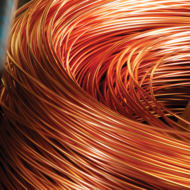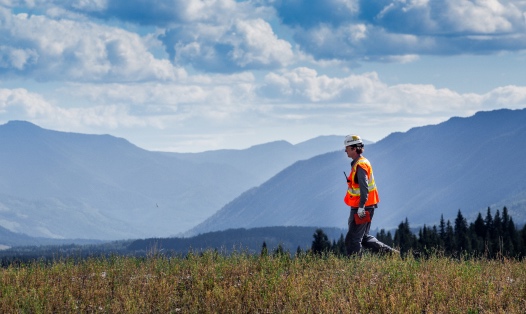How this $25 million fund is tapping into our greatest source of ideas: our people.
Have you ever had a great idea but didn’t know who to talk to about it, how to fund it, or if it would even work? Most of us have. And so that great idea—something that could have been truly transformational—never goes any further.
It’s this very common experience that led President and CEO Don Lindsay to create Teck’s Ideas at Work Fund, a $25 million fund to help bring to life breakthrough ideas and innovations in safety, environmental performance, productivity and cost savings.
We know our best ideas come from our people and since the fund was announced last November, dozens of submissions from employees across Teck have been received. Here, we look at two ideas that are being brought to life thanks to the Ideas at Work Fund.
Idea at Work: Real-Time Road Dust Monitoring at Trail Operations
Funding: $100,000
Key Potential Benefits: Improved Air Quality, Reduction in Water Use
The fugitive dust team at Trail Operations is known for having big ideas. In fact, the team has developed many projects that have improved air quality in the community by reducing dust that escapes from roadways, buildings and stockpiles.
Their most recent big idea uses technology to reinvent dust management on roadways and is being championed by cross-functional team members Keith Klimchuk, Senior Environmental Specialist; John Morassut, Operation Superintendent, Property Services; and Steven Martin, Group Leader of Applications and Information, Digital Systems.
Challenge
Historically, road dust at Trail Operations has been managed by hours of cleaning and washing roadways in and around the operation. Reducing fugitive dust is key to further reducing ambient lead levels in the community, and, in recent years, Trail Operations has been achieving record improvements in ambient air quality. Lead in community ambient air has been reduced by 47% since 2016, and the 2018 annual average for lead in ambient air at the Butler Park monitoring station was 0.13 ug/m3, the lowest-ever recorded annual average.
Idea
To further build on this progress, in July 2018 real-time road dust monitoring was implemented to better identify dust “hot spots”—sections of road where current controls could be improved and where cleaning and washing should be prioritized.
At the time, there was no commercially available instrument available, so the Trail Operations team developed one. Keith, Steven and John, along with metals tradesperson Dave Olson, created a road dust-monitoring tool that attaches to a truck’s trailer hitch and measures wheel-generated dust around site in real time. Then, by merging data from independent dust monitoring and GPS measurement tools, a road dust map for the site
is created.
With the addition of funding from Ideas at Work, the next step will be to automate this tool so that a road dust map will be produced while the truck is being driven.
What’s Next
The team plans to add smart tool functionality, incorporating sensor data for cleaning and washing with the road dust data, and then to use data analytics for further optimization. As a result, an additional benefit may be a reduction in water use at site.
This next phase of the project is also being assessed for use at other sites, including coal operations in the Elk Valley.
“In 2018, collaboration between Environment, Material Movement and Teck Digital Systems was key to transforming an idea into a fully functional tool,” says Keith. “Ideas at Work has expanded our radius of collaboration to include contributions from all areas of Teck, and made it possible to apply this tool at other sites.”
Idea at Work: Seismic While Drilling at Line Creek Operations
Funding: $13,000
Key Potential Benefit: Improved Accuracy in Mapping and Extracting Coal
Understanding exactly what’s underground is invaluable to those working above it. Finding a better way to capture this info is what’s driving Chris Lane, Senior Geologist Supervisor at Line Creek Operations (LCO), and Victoria Sterritt, Manager, Race21TM Technology Delivery, to champion the idea of mounting seismic sensors on drill masts.
Challenge
Coal operations currently use “measure while drilling” (MWD) information from drill operating parameters (e.g., pull down, rotational speed) to provide geologists, drill and blast engineers, and process control specialists with an indication of rock type and hardness. Due to subtle hardness differences, MWD data can prove challenging when distinguishing between coal and shale.
Idea
Supported by LCO’s Geology and Technology and Innovation groups, Chris and Victoria are working collaboratively with a third-party company, DataCloud, to test the ability of seismic sensors to provide superior rock type identification, including coal identification. DataCloud has developed an early stage technology called RHINO to provide “seismic while drilling” (SWD) information from blastholes.
SWD data may be able to distinguish coal seams in blasthole data more reliably, enabling more accurate mapping and extraction of coal, and reducing over-drilling into economic coal seams.
What’s Next
A proof-of-concept trial was completed in April, and the initial results are promising, says Chris. “We’re excited about the potential for seismic sensors mounted on drill masts to improve rock type identification across our operations. The Ideas at Work Fund has made it possible for us to test the viability of this employee idea and, based on the initial results, we think this concept could have a promising future.”
Have an Idea?
If you have an idea for consideration for the Ideas at Work Fund, discuss it with your supervisor, or submit it through the Ideas at Work process in place at your site of office. Eligible ideas will be shared with General Managers and corporate department Vice Presidents, who can then help take them forward for further consideration.
An Ideas at Work Fund form is also available on connect.teck to provide guidance on things to consider when bringing an idea forward. Completing this form is a helpful way to prepare for discussions around your idea, but not required as part of the submission process.
For further assistance with developing idea submissions, the Technology and Innovation group is also available to help as well, by contacting Keith Mayhew, Manager, Technology and Innovation or Daniel Parker, Superintendent, Mine Operations, Fording River Operations.


